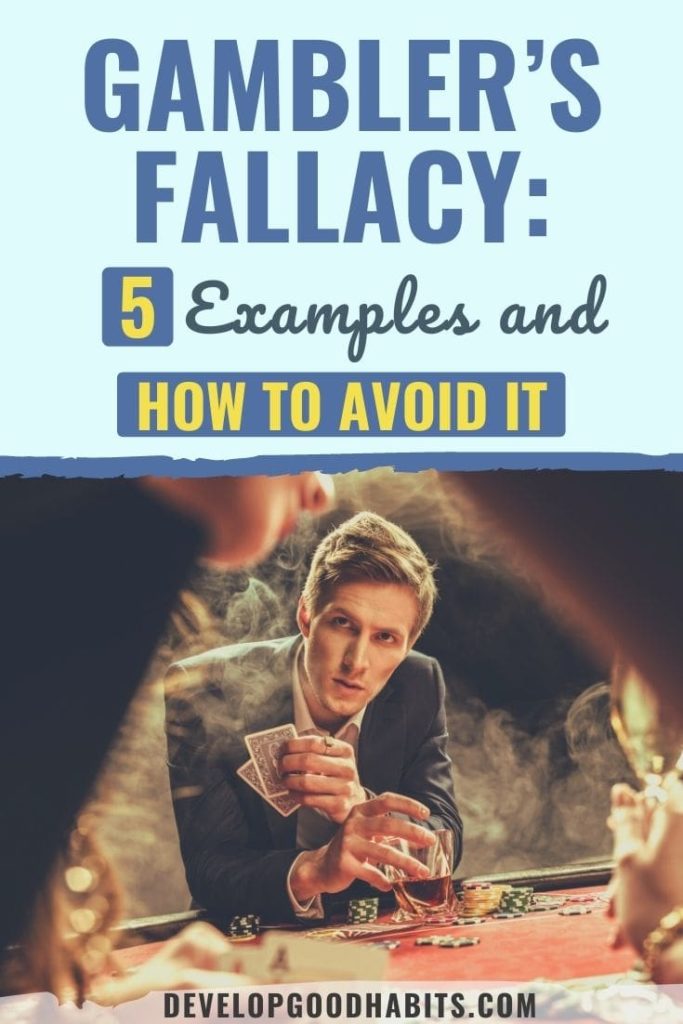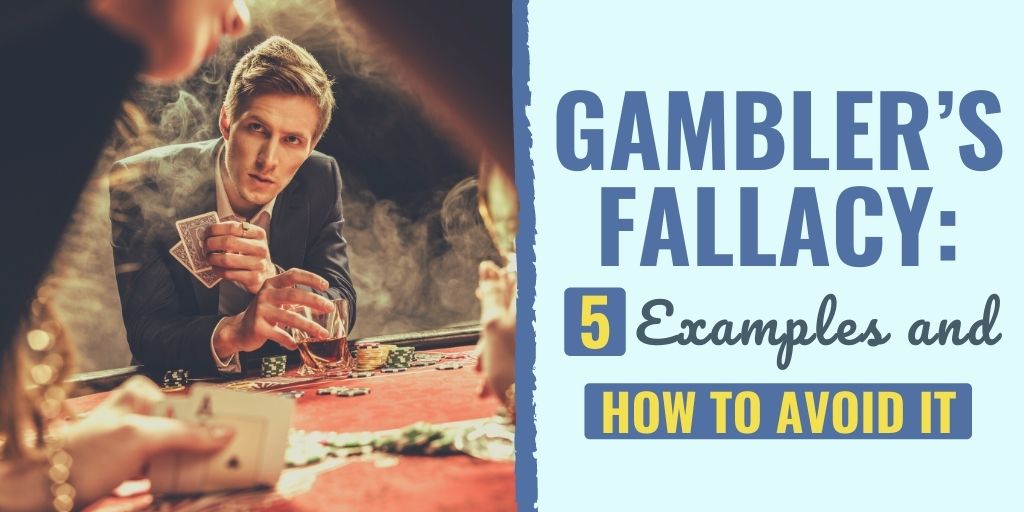There might be affiliate links on this page, which means we get a small commission of anything you buy. As an Amazon Associate we earn from qualifying purchases. Please do your own research before making any online purchase.
I have a good friend who recently gave birth to her fourth child, a baby boy. She and her husband waited until he was born to find out the sex of the baby, and the results came as a surprise to friends and family, as many had bet on their final child being a girl.
Why?
Well with three boys already, it felt like the family was “due” a girl. The chances of that fourth baby being a boy felt so small.
But why did it seem more unlikely for their fourth child to be a boy than it did for their first?
This common method of reasoning is known as the gambler’s fallacy, and if you’re not aware of it, this faulty logic could negatively impact your future decisions. So, in this article, we will define the gambler’s fallacy and look at five examples of this cognitive bias. Then, we will look at how you can prevent this logical fallacy from influencing your thoughts.
Let’s get started.
What Is the Gambler’s Fallacy?
The gambler’s fallacy can be best understood through the simple example of a coin toss. If your coin lands on head three times in a row, the gambler’s fallacy would predict that the next toss would land on tails. That is, the result of the next coin toss is somehow impacted by the results of the last three tosses.
Logically, we know a fair coin has a 50% chance of landing heads up and an equal chance of landing heads down. Each flip is independent from the last and not impacted by any other toss. But this logic doesn’t always translate to real life.
According to research, people hold the fallacious belief that past random outcomes influence future random outcomes because, in the case of the coin toss, we expect it to land on tails exactly half the time. So, if it has landed on heads several times in a row, we expect a deviation from this result to “even out” the end result ratio to 50/50.
This means that if a coin has been tossed three times and it landed on heads each time, people tend to think the chance that it will land on tails on the next toss is greater than 50% because the ratio outcome needs to be corrected from the first three tosses. But, expecting deviations from the “norm” to be corrected by random processes is illogical.
We expect ratios to be properly represented, regardless of whether a coin is tossed four times or 4,000 times. Without thinking logically, we think coins always obey the law of averages.
But if you were to look at a list of 4,000 coin flips, the overall ratio of heads to tails would be near 1:1. And, if the list extended to 400 billion, the ratio would be even more exact. But, if you focused in on just a handful of flips, you would notice streaks of one outcome or the other that isn’t representative of the 50/50 odds. While these small sequences don’t impact the ratio in a large collection of flips, they do show that the coin can’t sense when it needs a new result.
So how does this play out in everyday life? Let’s take a look at some examples.
5 Everyday Examples of the Gambler’s Fallacy
1. Securing a Loan
Studies have found steady evidence of people thinking in terms of the gambler’s fallacy in professional positions. This has been seen through “negatively autocorrelated” decision-making behaviors in loan officers, in that professionals in this field avoid approving several loans in a row because they assume sequential streaks can’t occur by chance. This may lead a loan officer to deny a loan application that they otherwise would have approved if it had been assessed completely independently from the rest.
While one loan is unrelated to the next, less experienced decision-makers (and especially those without an incentive to be accurate) see them all as being connected and therefore exercise their own control in a process that is otherwise supposed to be random.
2. Investing
Investors have been known to make poor decisions because of the gambler’s fallacy. For example, after an investment has made a series of gains in subsequent trading sessions, investors may feel inclined to cash out on the investment because it’s “due for” a downward turn.
Alternatively, an investor may hang on to a stock that has recently declined multiple times because they believe it’s not probable that the stock will continue to lose value. However, just because a stock has gone down in four trading sessions in a row doesn’t decrease the likelihood that it will continue to decline in the next session.
But buying stock because you think a continued downward trend is likely to correct itself at any point is irrational. Instead, you should base your investment decisions on a full, evidence-based assessment before trying to predict a trend.
3. Flying
A frequently reported example of this cognitive bias is when people who frequently fly think that because they fly a lot, they’re “due” to be in a plane crash sooner or later.
Logically speaking, this isn’t true, because each plane trip is completely independent of the rest. Every time you board a traditional flight, your chances of that plane going down are about one in 11 million. That doesn’t change, whether you’re on your first flight or your 900th.
4. In Sports
When a sports team is on a streak–whether it’s a winning or a losing streak–those who fall for the gambler’s fallacy will always expect the next game to end the streak. What’s more, people expect one series to be followed by a similar series of the opposite result. This means after 5 losses in a row, onlookers may expect a sports team to have 5 sequential wins.
But imagine if sports were to end up being even after every season. Wouldn’t all teams break even?
5. Gambling
This logical fallacy is also referred to as the “Monte Carlo” fallacy after a 1913 anecdote from the Monte Carlo Casino.
It’s said that on this night, the roulette ball landed on black 26 times in a row, which was unheard of, even by seasoned gamblers. The casino made millions of dollars that night because of this logical fallacy because bettors kept putting money down on the streak ending.
The bettors who lost their money that night were unfortunately confident that the wheel had to realize its inaccurate ratio and land on red to even it out. So anyone who bet before the 27th spin expecting a turn of luck endured massive losses.

As with in this example, those with the gambler's fallacy in mind unreasonably expect losing (or winning) streaks to reverse. Studies of the behavior of online gamblers have found that people who win one game are more likely to win the next (due to the tendency to choose safer odds after winning) and those who lost had a higher probability of losing a second time (because they took riskier odds than usual).
However, picking safer odds after winning and taking bigger chances after losing shows that online gamblers predicted their luck would reverse, meaning they fell prey to the gamblers’ fallacy.
Why Do We Fall for the Gambler’s Fallacy?
An equally fair question to ask may be, “Why is gambling so addictive?”
One reason is because people think that gambling is ultimately part of a “fair” system, where any incurred losses are eventually corrected by a win. But, gamblers forget that casinos deal millions of bets and very few end up being profitable for the gambler.
Let’s say one in 1,000 rolls, tosses, or hands makes a significant amount of money. Casinos can handle the odds when they’re playing such a large number of games. But when playing in smaller bursts of, say, 10 games, a gambler can pretty much count on losing. But this is easy to lose sight of when you feel that you’re “due” for a win.
Another reason is simply because people don’t like randomness because it’s unpredictable. Most prefer predictability, order, and things that can be easily explained. So when something random is in control, we look for patterns or historical clues from similar events–even if they’re unrelated. Rationalizing random events and creating an explanation for them helps us make sense of chaos and make life seem more predictable.
How to Avoid the Gambler’s Fallacy
We often look toward the past to make decisions about the future. For example, if you look outside and see it’s overcast, you might grab an umbrella for the day. In the case that it rained, you wouldn’t be surprised, because this has been the outcome in the past of overcast conditions. A large element of making informed decisions about a future event is taking its relationship with past events into consideration. However, in this case, the two factors have a cause and effect relationship.
One fail-proof method of avoiding falling prey to the gambler’s fallacy is simple: get older. Simple, but true. Studies have shown that as people get older, they’re less likely to fall for this cognitive fallacy.
The main thing that you have to keep in mind when trying to avoid the gambler’s fallacy is whether or not the past events and potential upcoming events are dependent upon each other in any way. If they aren’t, and your prediction is based on a past outcome, you’ve fallen for the gambler’s fallacy. The only way you can avoid this is to disregard irrelevant events from the past and only take relevant data into account.
Thinking through the processes that lead to an event can help you recognize that past outcomes don’t play a role in future outcomes. But it’s also helpful to consider why you might think a past event has an influence on a future one, without giving any weight to superstition.
Finally, researchers have found that trying to teach people about randomness and probability is not effective in reducing the gambler’s fallacy. However, people have avoided falling for this fallacy when they’re trained to treat each outcome of a random series as if it were the beginning of the series rather than a continuation of events. Maintaining this mindset may prevent you from mistakenly hoping your chances of winning when gambling are expected to increase based on the results of previous events.
Final Thoughts on the Gambler’s Fallacy
Gambling is one aspect in life where perseverance doesn’t pay off. Whether you play once or you play a million times, your odds of winning each game remains the same. So, if you’ve been playing the lottery for years, don’t expect that you’re “due to win any day now”.
Next time you suspect you may be thinking in terms of the gambler’s fallacy, think back to these examples in detail and consider what factors are influencing your thoughts. Doing so can help you avoid falling prey to this cognitive fallacy.
Learn More About Logical Fallacies
If you want to expand your knowledge about the different logical fallacies and learn how to avoid them, check out our other posts:
- 5 Appeal to Nature Fallacy Examples in Media and Life
- 6 Outcome Bias Examples That Can Negatively Impact Your Decisions
- 7 Self-Serving Bias Examples You See Throughout Life
- 7 Omission Bias Examples That Negatively Impact Your Life
- 6 Authority Bias Examples That Might Impact Your Decisions
- 5 Burden of Proof Fallacy Examples
- 5 Appeal to Tradition Fallacy Examples in Life
- 5 Appeal to Authority Logical Fallacy Examples
- 7 False Cause Fallacy Examples
- 7 Appeal to Ignorance Fallacy Examples
- 7 Appeal to Common Sense Logical Fallacy Examples
- 5 Post Hoc Fallacy Examples (and How to Respond to This Argument)
- 5 Appeal to Anger Fallacy Examples Throughout Life
- 7 Halo Effect Bias Examples in Your Daily Life
- 7 Poisoning the Well Examples Throughout Your Life
- 7 Survivorship Bias Examples You See in the Real World
- 7 Dunning Kruger Effect Examples in Your Life
- 7 Either Or (“False Dilemma”) Fallacy Examples in Real Life
- 5 Cui Bono Fallacy Examples to Find Out “Who Will Benefit”
- 6 Anchoring Bias Examples That Impact Your Decisions
- 7 Virtue Signaling Examples in Everyday Life
- 7 Cherry Picking Fallacy Examples for When People Ignore Evidence
- 9 Circular Reasoning Examples (or “Begging the Question”) in Everyday Life
- 9 Appeal to Emotion Logical Fallacy Examples
- 9 Appeal to Pity Fallacy (“Ad Misericordiam”) Examples in Everyday Life
- 9 Loaded Question Fallacy Examples in Life and Media
- 9 Confirmation Bias Fallacy Examples In Everyday Life
- 9 Bandwagon Fallacy Examples to Prevent Poor Decisions
- 5 Red Herring Fallacy Examples to Fight Irrelevant Information
- 9 Middle Ground Fallacy Examples to Spot During an Argument
- 5 False Equivalence Examples to Know Before Your Next Argument
- 7 Hasty Generalization Fallacy Examples & How to Respond to Them
- 6 Straw Man Fallacy Examples & How You Can Respond
- 6 False Dichotomy Examples & How to Counter Them
- 7 Slippery Slope Fallacy Examples (And How to Counter Them)
- What is the Planning Fallacy?
- How to Overcome the “Sunk Cost Fallacy” Mindset
Finally, if you want a simple process to counter the logical fallacies and cognitive biases you encounter in life, then follow this 7-step process to develop the critical thinking skills habit.

Connie Mathers is a professional editor and freelance writer. She holds a Bachelor's Degree in Marketing and a Master’s Degree in Social Work. When she is not writing, Connie is either spending time with her daughter and two dogs, running, or working at her full-time job as a social worker in Richmond, VA.


